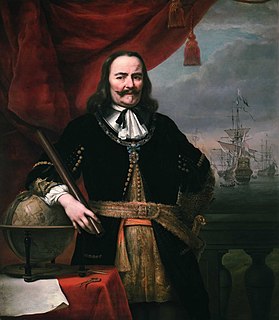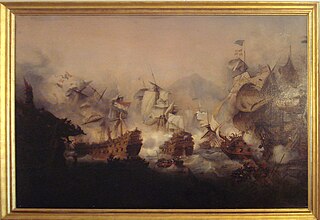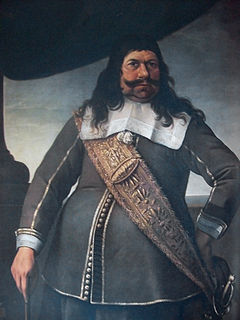| |||||
| Decades: | |||||
|---|---|---|---|---|---|
| See also: | Other events of 1673 History of France • Timeline • Years | ||||
Events from the year 1673 in France
| |||||
| Decades: | |||||
|---|---|---|---|---|---|
| See also: | Other events of 1673 History of France • Timeline • Years | ||||
Events from the year 1673 in France

The 1670s decade ran from January 1, 1670, to December 31, 1679.

1673 (MDCLXXIII) was a common year starting on Sunday of the Gregorian calendar and a common year starting on Wednesday of the Julian calendar, the 1673rd year of the Common Era (CE) and Anno Domini (AD) designations, the 673rd year of the 2nd millennium, the 73rd year of the 17th century, and the 4th year of the 1670s decade. As of the start of 1673, the Gregorian calendar was 10 days ahead of the Julian calendar, which remained in localized use until 1923.

The Third Anglo-Dutch War, or Third Dutch War, was a naval conflict between England, in alliance with France, and the Dutch Republic. It lasted from 7 April 1672 to 19 February 1674, and was a subsidiary of the wider 1672 to 1678 Franco-Dutch War.

Michiel Adriaenszoon de Ruyter was a Dutch admiral. Widely celebrated and regarded as one of the most skilled admirals in history, De Ruyter is arguably most famous for his achievements with the Dutch Navy during the Anglo-Dutch Wars. He fought the English and French forces and scored several critical victories, with the Raid on the Medway being the most famous among them.

The naval Battle of Texel or Battle of Kijkduin took place off the southern coast of island of Texel on 21 August 1673 between the Dutch and the combined English and French fleets. It was the last major battle of the Third Anglo-Dutch War, which was itself part of the Franco-Dutch War (1672–1678), during which Louis XIV of France invaded the Republic and sought to establish control over the Spanish Netherlands. English involvement came about because of the Treaty of Dover, secretly concluded by Charles II of England, and which was highly unpopular with the English Parliament.

Cornelis Maartenszoon Tromp was a Dutch naval officer who served as lieutenant-admiral general in the Dutch Navy, and briefly as a general admiral in the Royal Danish Navy. Tromp fought in the Anglo-Dutch Wars and the Scanian War. His father was Lieutenant Admiral Maarten Tromp.

Admiral of the Fleet Sir George Rooke was an English naval officer. As a junior officer he saw action at the Battle of Solebay and again at the Battle of Schooneveld during the Third Anglo-Dutch War. As a captain, he conveyed Prince William of Orange to England and took part in the Battle of Bantry Bay during the Williamite War in Ireland.

Abraham Duquesne, marquis du Bouchet was a French naval officer, who also saw service as an admiral in the Swedish navy. He was born in Dieppe, a seaport, in 1610, and was a Huguenot. He was the son of a naval officer and therefore became a sailor himself, spending his early years in merchant service.

The naval Battle of Solebay took place on 28 May Old Style, 7 June New Style 1672 and was the first naval battle of the Third Anglo-Dutch War. The battle ended inconclusively, with both sides claiming victory.

Philips van Almonde was a Dutch Lieutenant Admiral, who served in his nation’s maritime conflicts of the 17th and early 18th centuries.

The Battles of Schooneveld were two naval battles of the Franco-Dutch War, fought off the coast of the Netherlands on 7 June and 14 June 1673 between an allied Anglo-French fleet commanded by Prince Rupert of the Rhine on his flagship the Royal Charles, and the fleet of the United Provinces, commanded by Michiel de Ruyter.

The naval Battle of Stromboli sometimes called the Second Battle of Stromboli or the Battle of Alicuri, took place on 8 January 1676 during the Franco-Dutch War between a French fleet of 20 ships under Abraham Duquesne and a combined fleet of 19 allied ships under Lieutenant-Admiral-General Michiel de Ruyter that lasted eight hours and ended inconclusively. The fleets fought again at the Battle of Augusta.

The naval Battle of Augusta, sometimes spelled Agosta and also known as the Battle of Etna, took place on 22 April 1676 during the Franco-Dutch War and was fought between a French fleet of 29 man-of-war, five frigates and eight fireships under Abraham Duquesne, and a Dutch-Spanish fleet of at least 27 warships besides several frigates and five fireships with a Spanish admiral in overall command and Dutch Lieutenant-Admiral-General Michiel de Ruyter commanding the squadron most involved in the fighting.

Adriaen van Trappen Banckert was a Dutch admiral. In English literature he is sometimes known as Banckers. His first name is often rendered in the modern spelling Adriaan. Van Trappen was the original family name, but the family was also and better known under the name of Banckert. In the 17th century Netherlands such a situation was solved by combining the two names.
Philippe Marquis de Villette-Mursay was a French naval commander.

De Zeven Provinciën was a Dutch ship of the line, originally armed with 80 guns. The name of the ship refers to the seven autonomous provinces that made up the Dutch Republic in the 17th century. The vessel was built in 1664-65 for the Admiralty of de Maze in Rotterdam by the master shipbuilder Salomon Jansz van den Tempel.
Events from the year 1673 in England.
The naval history of the Netherlands dates back to the 15th century. As overseas trade was a traditional cornerstone of the Dutch economy, naval defence was indispensable for the protection of commercial interests.

Engel Michielszoon de Ruyter was a Dutch vice-admiral.

Enno Doedes Star was a Dutch admiral.